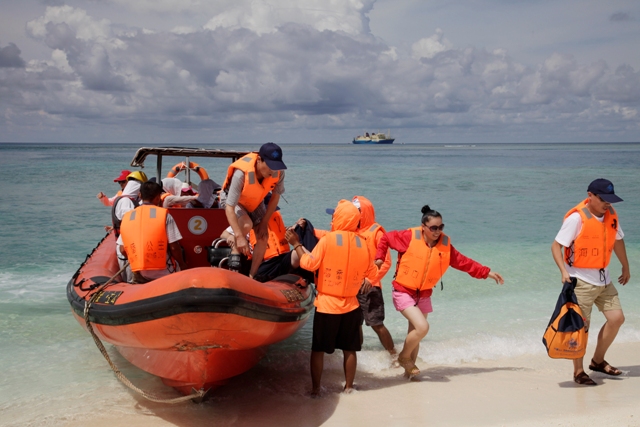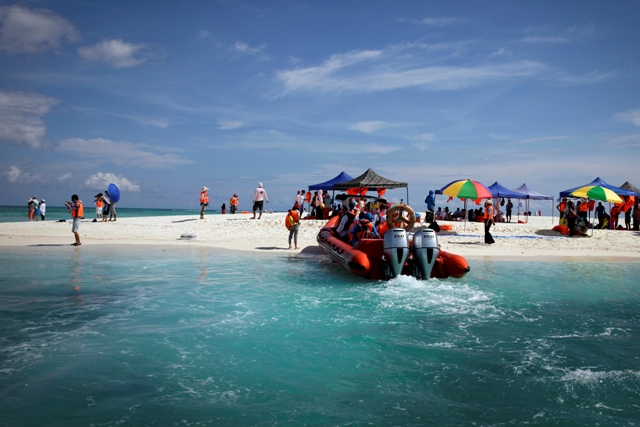Chinese patriotism fuels cruises to disputed isles
ABOARD THE COCONUT PRINCESS — Zhang Jing watched the gray shells of the Paracel Islands emerge from the purple, pre-dawn South China Sea. Here was the focal point of a cruise more about politics than pleasure.
Cheers erupted on board at the sight of the distant land, and Zhang and the other passengers scurried to take pictures of each other at the railing holding China's bright red flag. A few miles away, a Chinese navy frigate cruised by silently, part of the country's continuing watch over the tiny islands it has long claimed as part of its territory.
"This is the southern frontier of China," Zhang, a policeman, said when he had reached one of the islands. "As a Chinese, I feel proud to come here and declare sovereignty."
With the Tangshan resident and 167 other Chinese tourists on board, the ship had traveled more than 200 miles south of Hainan Island off China's southern coast to what they said was an indisputable outpost of their country.
Each had waited months for permission to join the five-day tour, and spent from $1,200 to about $2,000 to visit these barren patches of sand, making do with the bland cabbage and noodles on board and blackouts of cellphone service.

In this Sept. 14, 2014 photo, Chinese tourists disembark from an inflatable boat upon arrival in Quanfu island, a Paracels of Sansha prefecture of China's Hainan province. AP/Peng Peng
The passengers came to celebrate China's growing power in the region, and to help press its claim to the 130 coral islands and reefs of the Paracels, known to the Chinese as the Xishas.
China is locked in disputes with Vietnam, the Philippines and other neighbors over much of the strategically crucial South China Sea, which holds important shipping lanes, rich fishing waters and — possibly — billions of barrels of oil. Patriotic tourists have become the region's latest territorial chess pieces.
China has stationed hundreds of troops on the Paracels and even built a massive government headquarters in the northern islands, though Vietnam and Taiwan also claim the territory.
The tour company that Zhang used visits the southern Paracels. Since starting the tours in May 2013, it has ferried some 3,000 people to the islands, which are no bigger than a square mile. Videographers from The Associated Press were the first foreign journalists to join one of the tours.
The cruises are useful to China because under international law, it must prove a civilian and not just a military use for the islands to claim sovereignty, said Kang Lin, a researcher at China's National Institute for South China Sea Studies.
"Tourism to Xisha is a very good civilian tool to declare our sovereignty over the islands, and it is supported by international laws," Kang said. "China will speed up its exploration in the Xisha Islands."
The dispute has at times become heated, and there are concerns it could escalate. Over the summer, Vietnamese and Chinese boats repeatedly rammed each other in the Spratly Islands, several hundred miles south of the Paracels, after the Chinese moved an oil rig into contested waters.
Bernard Loo Fook Weng, a military studies professor at the S. Rajaratnam School of International Studies in Singapore, said stoking nationalist fervor could backfire on leaders in Beijing if they eventually opt for a more conciliatory approach with China's neighbors.
"Playing the popular card is always potentially dangerous because you may unleash forces you can't control," Weng said. "But if the Chinese really want to reinforce its claims to the Paracels and if necessary resort to military force, it helps to get the population on its side."
Other than the passing navy frigate and a few sailors hitching a ride on the Coconut Princess, the tour group saw few signs of territorial tensions.
At dawn on the second day, the ship anchored a few miles off the coast of what the Chinese call Quanfu Island. Later, motorized inflatable boats took the visitors to three different islands where they snorkeled, swam and posed for pictures with their ever-present flags.
Chen Junxiang, an environmental agency official from the central Chinese province of Sichuan, donned an oxygen tank and dove among the coral and fish off Yagong Island. He said coming here was a lifelong dream, though he could have taken a more luxurious cruise somewhere else for the same money.
"I am here for tourism, but also to declare sovereignty and advocate for environmental protection," Chen said. "We really should protect the environment here, otherwise we have nothing to leave for our next generations."

IIn this Sept. 14, 2014 photo, Chinese tourists enjoy scenic on the Quanfu island, a Paracels of Sansha prefecture of China's Hainan province. AP/Peng Peng
Fisherman Fan Qiusheng waited for the group on the beach of Yingyu Island outside the wood-and-tarp shack where he lives nine months of the year. He and 18 other people are paid to live on the island; he said the central government gives him 1,350 yuan ($220) a month plus food, water, electricity and other supplies. His wife and five children live on Hainan, and he visits them about every two months.
"Making money is important, but keeping the islands is also important," Fan said. "If we don't live on these islands, other people like the Vietnamese will come and stay here. We are living here, so these islands are our territory."
___
Jack Chang reported from Beijing.
- Latest





























